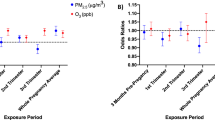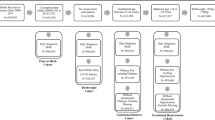Abstract
Previous research demonstrated consistent associations between ambient air pollution and emergency room visits, hospitalizations, and mortality. Effect of air pollution on perinatal outcomes has recently drawn more attention. We examined the association between intrauterine growth restriction (IUGR) among singleton term live births and sulfur dioxide (SO2), nitrogen dioxide (NO2), carbon monoxide (CO), ozone (O3), and fine particles (PM2.5) present in ambient air in the Canadian cities of Calgary, Edmonton, and Montreal for the period 1985–2000. Multiple logistic regression was used to estimate odds ratios (ORs) and 95% confidence intervals (CIs) for IUGR, based on average daily levels of individual pollutants over each month and trimester of pregnancy after adjustment for maternal age, parity, infant gender, season, and city of residence. A 1 ppm increase in CO was associated with an increased risk of IUGR in the first (OR=1.18; 95% CI 1.14–1.23), second (OR=1.15; 95% CI 1.10–1.19) and third (OR=1.19; 95% CI 1.14–1.24) trimesters of pregnancy, respectively. A 20 ppb increase in NO2 (OR=1.16; 95% CI 1.09–1.24; OR=1.14; 95% CI 1.06–1.21; and OR=1.16; 95% CI 1.09–1.24 in the first, second, and third trimesters) and a 10 μg/m3 increase in PM2.5 (OR=1.07; 95% CI 1.03–1.10; OR=1.06; 95% CI 1.03–1.10; and OR=1.06; 95% CI 1.03–1.10) were also associated with an increased risk of IUGR. Consistent results were found when ORs were calculated by month rather than trimester of pregnancy. Our findings add to the emerging body of evidence that exposure to relatively low levels of ambient air pollutants in urban areas during pregnancy is associated with adverse effects on fetal growth.
This is a preview of subscription content, access via your institution
Access options
Subscribe to this journal
Receive 6 print issues and online access
$259.00 per year
only $43.17 per issue
Buy this article
- Purchase on Springer Link
- Instant access to full article PDF
Prices may be subject to local taxes which are calculated during checkout







Similar content being viewed by others
References
Bobak M. Outdoor air pollution, low birth weight, and prematurity. Environ Health Perspect 2000: 108: 173–176.
Burnett R.T., Brook J., and Dann T., et al. Association between particulate and gasphase components of urban air pollution and daily mortality in eight Canadian cities. Inhal Toxicol 2000: 12(suppl 4): 15–39.
Burnett R.T., Dales R.E., Brook J.R., Raizenne M.E., and Krewski D. Association between ambient carbon monoxide levels and hospitalizations for congestive heart failure in the elderly in 10 Canadian cities. Epidemiology 1997: 8: 162–167.
Burnett R.T., Smith-Doiron M., and Stieb D., et al. Association between ozone and hospitalization for acute respiratory diseases in children less than 2 years of age. Am J Epidemiol 2001: 153: 444–452.
Dejmek J., Solansky I., Benes I., Lenicek J., and Sram R.J. The impact of polycyclic aromatic hydrocarbons and fine particles on pregnancy outcomes. Environ Health Perspect 2000: 108: 1159–1164.
Dejmek J., Solamsky I., Podrazilova K., and Sram R.J. Fetal growth and maternal exposure to particulate matter during pregnancy. Environ Health Perspect 1999: 107: 475–480.
Dockery D.W., Pope III C.A., and Xu X., et al. An association between air pollution and mortality in six U.S. cities. N Engl J Med 1993: 329: 1753–1759.
Duvekot J.J., Cheriex E.C., Pieters F.A., and Peeters L.L. Severely impaired growth is preceded by maternal hemodynamic maladaptation in very early pregnancy. Acta Obstet Gynecol Scand 1995: 74: 693–697.
Fair M.E., and Cyr M. The Canadian birth database: a new research tool to study reproductive outcomes. Health Rep 1993: 5: 281–290.
Janssen N.A., Hock G., Harssema H., and Brunekreef B. Personal exposure to fine particles in children correlates closely with ambient fine particles. Arch Environ Health 1999: 54: 95–100.
Janssen N.A., Hoek G., and Brunekreef B., et al. Personal sampling of particles in adults: relation among personal, indoor, and outdoor air concentrations. Am J Epidemiol 1998: 147: 537–547.
Jedrychowski W., Bendkowska I., and Flak E., et al. Estimated risk for altered fetal growth resulting from exposure to fine particles during pregnancy: an epidemiologic prospective cohort study in Poland. Environ Health Perspect 2004: 112: 1398–1402.
Kramer M.S. Intrauterine growth and gestational duration determinants. Pediatrics 1987: 80: 502–511.
Kramer M.S. The epidemiology of adverse pregnancy outcomes: an overview. J Nutr 2003: 133: 1592S–1596S.
Kramer M.S., Demissie K., and Yang H., et al. Fetal and Infant Health Study Group of the Canadian Perinatal Surveillance System. The contribution of mild and moderate preterm birth to infant mortality. JAMA 2000: 284: 843–849.
Landgren O. Environmental pollution and delivery outcome in southern Sweden: a study with central registries. Acta Paediatr 1996: 85: 1361–1364.
Lee B.E., Ha E.H., and Park H.S., et al. Exposure to air pollution during different gestational phases contributes to risks of low birth weight. Hum Reprod 2003: 18: 638–643.
Liu S., Krewski D., Shi Y., Chen Y., and Burnett R.T. Association between gaseous ambient air pollutants and adverse pregnancy outcomes in Vancouver, Canada. Environ Health Perspect 2003: 111: 1773–1778.
Liu S., Krewski D., Shi Y., Chen Y., and Burnett R.T. Correspondence: air pollution and adverse pregnancy outcomes: response. Environ Health Perspect 2004: 112: a792–794.
Longo L.D. Carbon monoxide: effects on oxygenation of the fetus in utero. Science 1976: 194: 523–525.
Maisonet M., Bush T.J., Correa A., and Jaakkola J.K. Relation between ambient air pollution and low birth weight in the Northeastern United States. Environ Health Perspect 2001: 109(suppl 3): 351–356.
Mallick R., Fung F., and Krewski D. Adjusting for measurement error in the Cox proportional hazards regression model. J Cancer Epidemiol Prev 2002: 7: 155–164.
Maroziene L., and Grazuleviciene R. Maternal exposure to low-level air pollution and pregnancy outcomes: a population-based study. Environmental Health: A Global Access Science Source 2002: 1: 6.
Moison R.M., Palinckx J.J., Roest M., Houdkamp E., and Berger H.M. Induction of lipid peroxidation of pulmonary surfactant by plasma of preterm babies. Lancet 1993: 341: 79–82.
Parker J.D., Woodruff T.J., Basu R., and Schoendorf K.C. Air pollution and birth weight among term infants in California. Pediatrics 2005: 115: 121–128.
Perera F.P., Jedrychowski W., Rauh V., and Whyatt R.M. Molecular epidemiologic research on the effects of environment: pollutants on the fetus. Environ Health Perspect 1999: 107(suppl 3): 451–460.
Perera F.P., Whyatt R.M., and Jedrychowski W., et al. Recent developments in molecular epidemiology. A study of the environmental polycyclic aromatic hydrocarbons on birth outcomes in Poland. Am J Epidemiol 1998: 147: 309–314.
Ritz B., and Yu F. The effect of ambient carbon monoxide on low birth weight among children born in Southern California between 1989 and 1993. Environ Health Perspect 1999: 107: 17–25.
Ritz B., Yu F., Chapa G., and Fruin S. Effect of air pollution on preterm birth among children born in Southern California between 1989 and 1993. Epidemiology 2000: 11: 502–511.
Ritz B., Yu F., and Fruin S., et al. Ambient air pollution and risk of birth effects in Southern California. Am J Epidemiol 2002: 155: 17–25.
Rothman K.J. Methodologic frontiers in environmental epidemiology. Environ Health Perspect 1993: 101: 19–21.
Rutledge J. Perimplantation teratology and the placenta. Teratology 2000: 61: 246–247.
Schwartz J., and Morris R. Air pollution and hospital admissions for cardiovascular disease in Detroit, Michigan. Am J Epidemiol 1995: 142: 23–35.
Smrcka V., and Leznarova D. Environmental pollution and the occurrence of congenital defects in a 15-year period in a south Moravian district. Acta Chir Plast 1998: 40: 112–114.
Tabacova S., Baird D.D., and Balabaeva L. Exposure to oxidized nitrogen: lipid erozidation and neonatal health risk. Arch Environ Health 1998: 53: 214–221.
Vorherr H. Factors influencing fetal growth. Am J Obstet Gynecol 1982: 142: 577–588.
Wang X., Ding H., Ryan L., and Xu X. Association between air pollution and low birth weight: a community-based study. Environ Health Perspect 1997: 105: 514–520.
Xu X., Ding H., and Wang X. Acute effects of total suspended particulate and sulfur dioxides on preterm delivery: a community-based cohort study. Arch Environ Health 1995: 50: 407–415.
Yang Q., Chen Y., Shi Y., Burnett R.T., McGrail K., and Krewski D. Association between ozone and respiratory admissions among children and the elderly in Vancouver, Canada. Inhal Toxicol 2003: 15: 1297–1308.
Zeger S.L., Thomas D., and Dominici F., et al. Exposure measurement error in time-series studies of air pollution: concepts and consequences. Environ Health Perspect 2000: 108: 419–426.
Acknowledgements
We are grateful to Environment Canada for air pollutant data and Statistics Canada for live birth data.
Author information
Authors and Affiliations
Corresponding author
Rights and permissions
About this article
Cite this article
Liu, S., Krewski, D., Shi, Y. et al. Association between maternal exposure to ambient air pollutants during pregnancy and fetal growth restriction. J Expo Sci Environ Epidemiol 17, 426–432 (2007). https://doi.org/10.1038/sj.jes.7500503
Received:
Revised:
Accepted:
Published:
Issue Date:
DOI: https://doi.org/10.1038/sj.jes.7500503
Keywords
This article is cited by
-
Label-free detection of uptake, accumulation, and translocation of diesel exhaust particles in ex vivo perfused human placenta
Journal of Nanobiotechnology (2021)
-
Association between moderated level of air pollution and fetal growth: the potential role of noise exposure
Scientific Reports (2021)
-
Ambient and household air pollution on early-life determinants of stunting—a systematic review and meta-analysis
Environmental Science and Pollution Research (2021)
-
Maternal exposure to ambient fine particulate matter and fetal growth in Shanghai, China
Environmental Health (2019)
-
Ambient black carbon particles reach the fetal side of human placenta
Nature Communications (2019)



